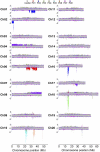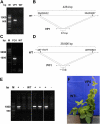Phenotypic and genomic analyses of a fast neutron mutant population resource in soybean
- PMID: 21321255
- PMCID: PMC3091049
- DOI: 10.1104/pp.110.170811
Phenotypic and genomic analyses of a fast neutron mutant population resource in soybean
Abstract
Mutagenized populations have become indispensable resources for introducing variation and studying gene function in plant genomics research. In this study, fast neutron (FN) radiation was used to induce deletion mutations in the soybean (Glycine max) genome. Approximately 120,000 soybean seeds were exposed to FN radiation doses of up to 32 Gray units to develop over 23,000 independent M2 lines. Here, we demonstrate the utility of this population for phenotypic screening and associated genomic characterization of striking and agronomically important traits. Plant variation was cataloged for seed composition, maturity, morphology, pigmentation, and nodulation traits. Mutants that showed significant increases or decreases in seed protein and oil content across multiple generations and environments were identified. The application of comparative genomic hybridization (CGH) to lesion-induced mutants for deletion mapping was validated on a midoleate x-ray mutant, M23, with a known FAD2-1A (for fatty acid desaturase) gene deletion. Using CGH, a subset of mutants was characterized, revealing deletion regions and candidate genes associated with phenotypes of interest. Exome resequencing and sequencing of PCR products confirmed FN-induced deletions detected by CGH. Beyond characterization of soybean FN mutants, this study demonstrates the utility of CGH, exome sequence capture, and next-generation sequencing approaches for analyses of mutant plant genomes. We present this FN mutant soybean population as a valuable public resource for future genetic screens and functional genomics research.
Figures






References
-
- Alonso JM, Ecker JR. (2006) Moving forward in reverse: genetic technologies to enable genome-wide phenomic screens in Arabidopsis. Nat Rev Genet 7: 524–536 - PubMed
-
- Alt JL, Fehr WR, Welke GA, Sandhu D. (2005) Phenotypic and molecular analysis of oleate content in the mutant soybean line M23. Crop Sci 45: 1997–2000
-
- Altschul SF, Gish W, Miller W, Myers EW, Lipman DJ. (1990) Basic local alignment search tool. J Mol Biol 215: 403–410 - PubMed
-
- Anai T, Yamada T, Hideshima R, Kinoshita T, Rahman SM, Takagi Y. (2008) Two high-oleic-acid soybean mutants, M23 and KK21, have disrupted microsomal omega-6 fatty acid desaturase, encoded by GmFAD2-1a. Breed Sci 58: 447–452
Publication types
MeSH terms
Substances
LinkOut - more resources
Full Text Sources
Other Literature Sources
Miscellaneous

